ポップアップショップは、日本のファッション小売業において重要な役割を果たしており、ブランドが一時的に製品を展示し、新しい顧客を引き付け、ユニークなショッピング体験を提供するプラットフォームを提供します。これらのショップは、小売業者が新しい市場を試し、消費者と革新的な方法で関わる機会を与えます。

How do pop-up shops influence Japanese fashion retail?
Pop-up shops significantly impact Japanese fashion retail by providing brands with a temporary platform to showcase their products, attract new customers, and create unique shopping experiences. These shops allow retailers to test new markets and engage with consumers in innovative ways.
Increased brand visibility
Pop-up shops enhance brand visibility by placing products in high-traffic areas, often in urban centers like Tokyo or Osaka. This strategic positioning helps brands reach a broader audience who may not be familiar with their offerings.
Utilizing eye-catching designs and interactive displays, these shops create memorable experiences that encourage social media sharing, further amplifying brand exposure. Collaborations with local artists or influencers can also boost visibility and attract attention.
Enhanced customer engagement
Pop-up shops foster direct interaction between brands and consumers, allowing for personalized shopping experiences. Customers can engage with staff, ask questions, and receive immediate feedback, which enhances their connection to the brand.
Events such as product launches, workshops, or fashion shows can be organized within these temporary spaces, encouraging participation and building a community around the brand. This engagement often leads to increased customer loyalty and repeat visits.
Limited-time exclusivity
The temporary nature of pop-up shops creates a sense of urgency among consumers, driving them to make quicker purchasing decisions. Limited-time offers or exclusive products available only at these shops can entice customers to visit and buy.
This strategy not only boosts sales but also generates buzz around the brand, as customers feel they are part of a unique experience. Brands can leverage this exclusivity to test new products or concepts before a wider release, minimizing risk while maximizing impact.
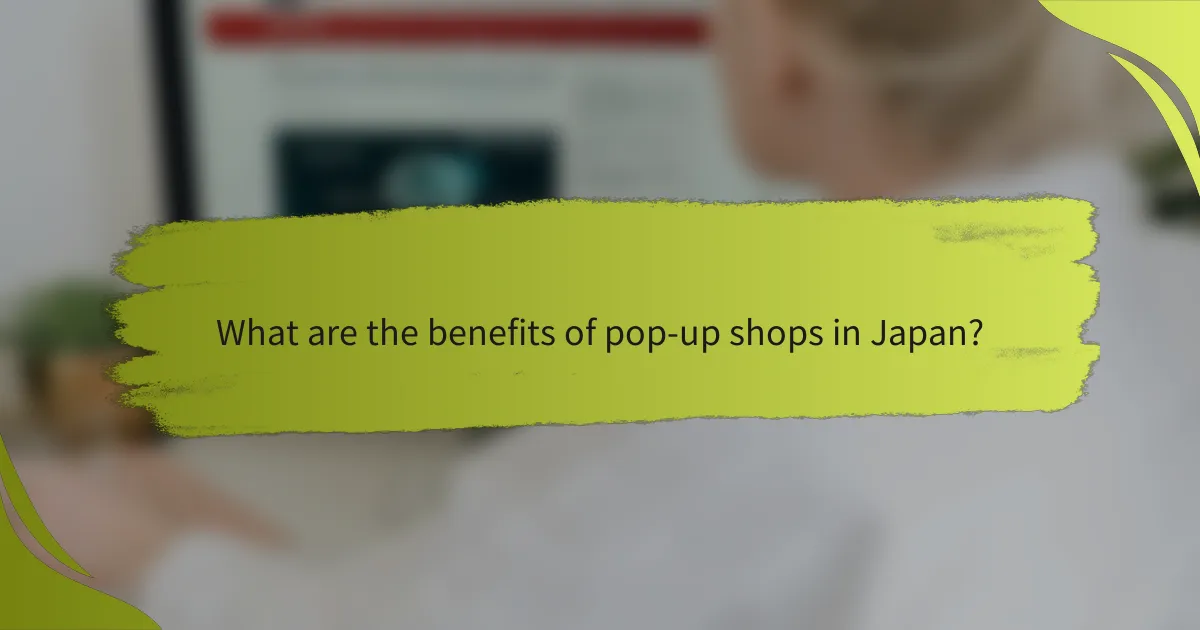
What are the benefits of pop-up shops in Japan?
Pop-up shops in Japan offer unique advantages for fashion retailers, including increased visibility, cost savings, and the ability to engage directly with customers. These temporary retail spaces allow brands to experiment with new concepts and reach diverse audiences without the long-term commitment of traditional stores.
Cost-effective marketing
Pop-up shops provide a cost-effective marketing strategy by minimizing overhead expenses associated with permanent locations. Retailers can allocate resources to create engaging experiences rather than maintaining a full-time storefront.
For instance, a fashion brand might set up a pop-up in a high-traffic area for a few weeks, allowing them to generate buzz and attract customers without the long-term lease costs. This approach can lead to significant savings while maximizing exposure.
Testing new markets
Pop-up shops allow brands to test new markets with minimal risk. By setting up temporary locations in different neighborhoods or cities, retailers can gauge customer interest and preferences before committing to a permanent presence.
For example, a Tokyo-based brand might launch a pop-up in Osaka to assess demand. This strategy helps brands understand local trends and tailor their offerings accordingly, ensuring a better fit for future expansions.
Building community connections
Establishing pop-up shops fosters community connections by creating a space for interaction between brands and consumers. These events often feature local artists, influencers, or workshops, enhancing the shopping experience and building brand loyalty.
By engaging with the community, retailers can gather valuable feedback and create a sense of belonging among customers. This connection can lead to repeat business and a stronger brand presence in the local market.
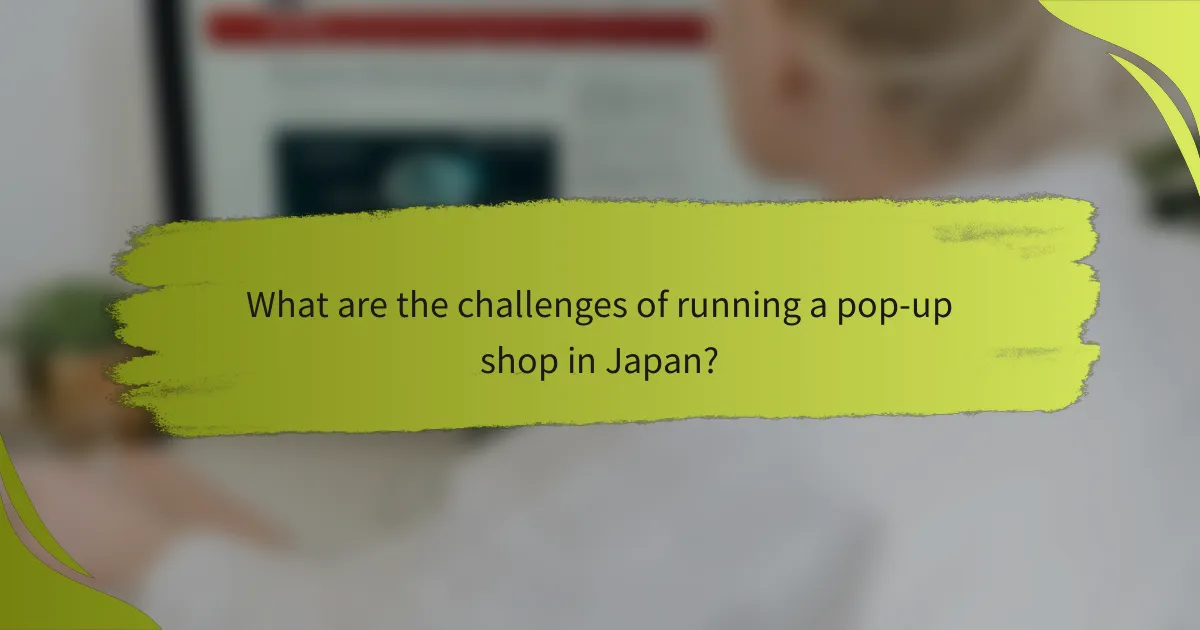
What are the challenges of running a pop-up shop in Japan?
Running a pop-up shop in Japan presents several challenges, including finding the right location, navigating regulatory requirements, and managing revenue uncertainties. These factors can significantly impact the success of a temporary retail venture.
Location selection difficulties
Choosing the right location for a pop-up shop in Japan is crucial, as foot traffic and visibility can vary greatly between neighborhoods. Popular areas like Shibuya or Harajuku may attract more customers but come with higher rental costs, while less busy districts might offer more affordable options but lower sales potential.
It’s essential to analyze local demographics and consumer behavior to ensure the chosen location aligns with the target audience. Conducting market research and visiting potential sites can help identify the best fit for the brand.
Regulatory compliance issues
Japan has specific regulations regarding retail operations, including permits for temporary shops. Before launching a pop-up, businesses must secure the necessary licenses, which can vary by city and type of merchandise sold.
Additionally, compliance with health and safety standards is mandatory. Familiarizing oneself with local laws and consulting with legal experts can prevent costly fines and operational delays.
Short-term revenue uncertainty
Revenue from pop-up shops can be unpredictable, as sales often depend on factors like location, marketing efforts, and seasonal trends. It’s common for pop-up shops to experience fluctuating sales, making it difficult to forecast profits accurately.
To mitigate risks, businesses should establish a clear budget and set realistic sales targets. Offering limited-time promotions or exclusive products can also help drive traffic and boost short-term sales.
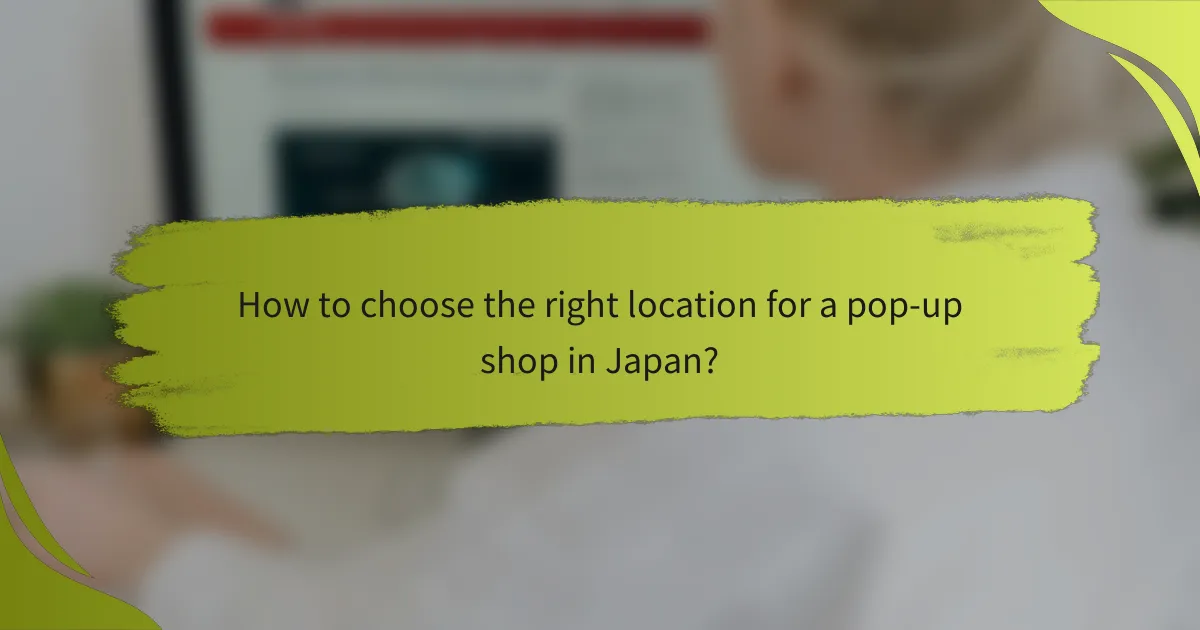
How to choose the right location for a pop-up shop in Japan?
Choosing the right location for a pop-up shop in Japan is crucial for attracting customers and maximizing sales. Key factors include foot traffic, alignment with your target demographic, and ensuring the shop is easily accessible and visible.
High foot traffic areas
High foot traffic areas are essential for pop-up shops as they increase visibility and potential sales. Locations such as shopping districts, major train stations, and popular tourist spots can draw large crowds. Consider areas like Shibuya or Harajuku in Tokyo, where foot traffic can reach thousands daily.
When selecting a site, observe the flow of people at different times of the day and week. Weekends and holidays typically see higher traffic, so plan your pop-up accordingly to capitalize on these peak times.
Target demographic alignment
Aligning your pop-up shop location with your target demographic is vital for success. Research the preferences and shopping habits of your intended audience to find the best fit. For example, if your brand appeals to young fashion enthusiasts, locations near universities or trendy neighborhoods may be ideal.
Utilize demographic data and local insights to refine your choice. Engaging with local influencers can also help you understand where your target customers are likely to shop.
Accessibility and visibility
Accessibility and visibility are key components in the success of a pop-up shop. Ensure that your location is easy to reach via public transport and has adequate parking options if needed. Locations near major train lines or bus routes can enhance accessibility.
Visibility is equally important; a shop that stands out can attract more customers. Use signage and window displays effectively to draw attention and make sure your shop is well-lit and inviting.
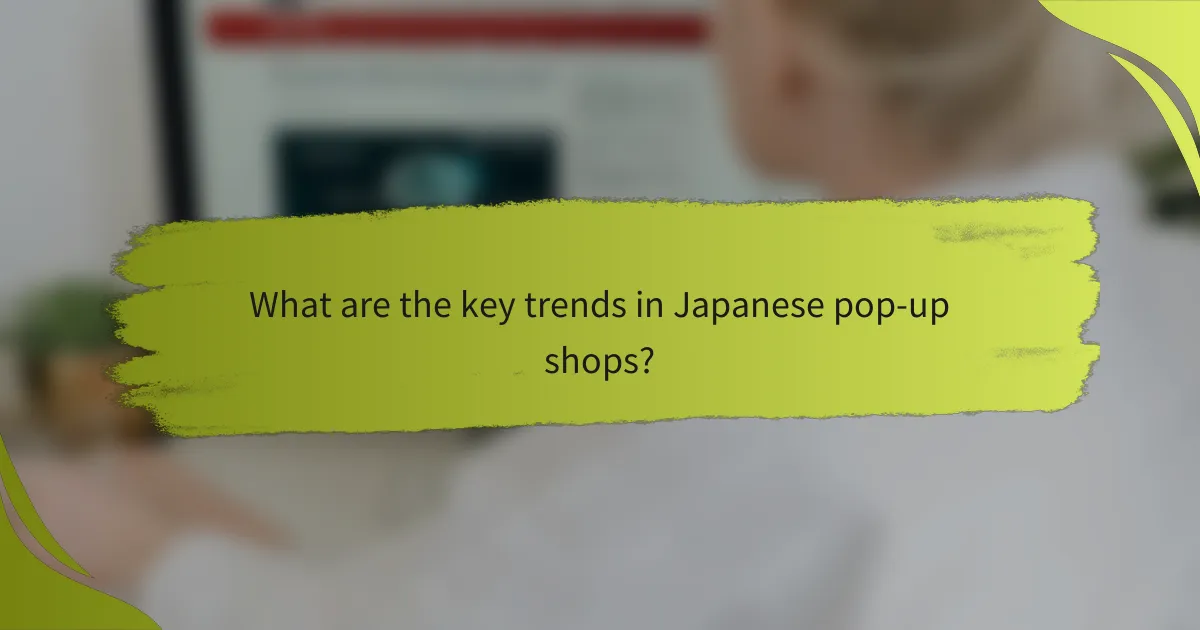
What are the key trends in Japanese pop-up shops?
Japanese pop-up shops are increasingly characterized by their integration with digital platforms, collaborations with local artists, and a strong focus on sustainability. These trends reflect the evolving landscape of retail, where consumer engagement and social responsibility play crucial roles.
Integration with online platforms
Pop-up shops in Japan are leveraging online platforms to enhance customer engagement and streamline sales processes. Many brands utilize social media and e-commerce sites to promote their temporary locations, allowing customers to discover and interact with them easily.
For instance, brands often announce pop-up events through Instagram, providing exclusive online discounts or pre-orders for items available only at the physical location. This strategy not only drives foot traffic but also creates a sense of urgency among consumers.
Collaboration with local artists
Collaborating with local artists has become a significant trend in Japanese pop-up shops, fostering community connections and enhancing brand identity. By featuring local talent, brands can offer unique, culturally relevant products that resonate with consumers.
These collaborations often include limited-edition merchandise, art installations, or live performances, creating an immersive shopping experience. For example, a fashion brand might partner with a local illustrator to design exclusive packaging or merchandise, appealing to both art enthusiasts and fashion consumers.
Focus on sustainability
Sustainability is a key focus for many Japanese pop-up shops, reflecting growing consumer awareness of environmental issues. Brands are increasingly adopting eco-friendly practices, such as using sustainable materials and reducing waste during their events.
Some pop-up shops implement take-back programs, encouraging customers to return used products for recycling or upcycling. This not only promotes responsible consumption but also builds brand loyalty among environmentally conscious consumers.
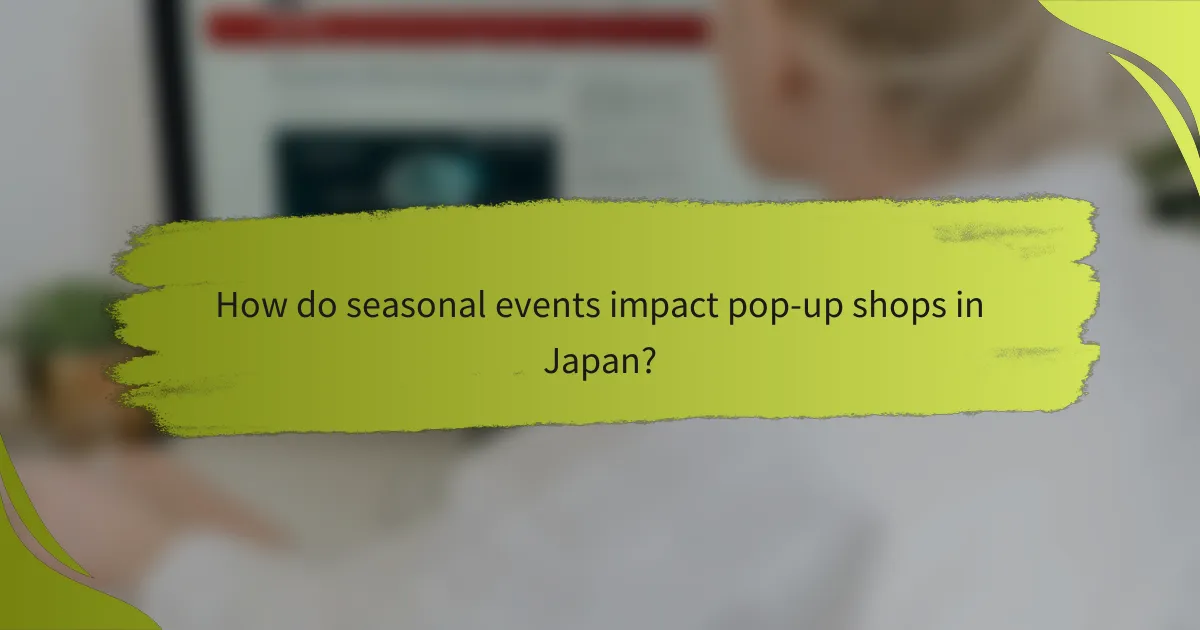
How do seasonal events impact pop-up shops in Japan?
Seasonal events significantly influence the operation and success of pop-up shops in Japan. These events create unique opportunities for retailers to engage customers with limited-time offerings that align with cultural festivities and shopping trends.
Key seasonal events affecting pop-up shops
In Japan, several key seasonal events impact pop-up shops, including Hanami (cherry blossom viewing), Tanabata (star festival), and the New Year celebrations. Each of these occasions presents a chance for retailers to tailor their products and marketing strategies to attract shoppers looking for themed items.
For example, during Hanami, many pop-up shops offer sakura-themed merchandise, such as clothing and accessories adorned with cherry blossom motifs. Similarly, during the New Year, retailers may focus on traditional items like osechi (New Year’s food) packaging or decorations.
Strategies for leveraging seasonal events
To effectively leverage seasonal events, pop-up shops should plan their inventory and marketing campaigns well in advance. This includes designing exclusive products that resonate with the event’s theme and utilizing social media to create buzz around the shop’s opening.
Engaging local influencers or participating in community events can further enhance visibility. For instance, collaborating with local artists to create limited-edition items can attract attention and drive foot traffic.
Challenges and considerations
While seasonal events offer great opportunities, pop-up shops must also navigate challenges such as competition and fluctuating consumer interest. It’s essential to conduct market research to understand customer preferences and adjust offerings accordingly.
Additionally, managing logistics, such as securing prime locations and ensuring adequate staffing during peak times, is crucial for success. Shops should also be prepared for potential supply chain disruptions, especially during high-demand periods.
